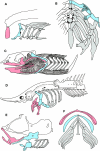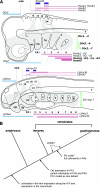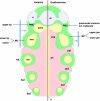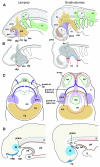Evolution of the vertebrate jaw: comparative embryology and molecular developmental biology reveal the factors behind evolutionary novelty
- PMID: 15575882
- PMCID: PMC1571356
- DOI: 10.1111/j.0021-8782.2004.00345.x
Evolution of the vertebrate jaw: comparative embryology and molecular developmental biology reveal the factors behind evolutionary novelty
Abstract
It is generally believed that the jaw arose through the simple transformation of an ancestral rostral gill arch. The gnathostome jaw differentiates from Hox-free crest cells in the mandibular arch, and this is also apparent in the lamprey. The basic Hox code, including the Hox-free default state in the mandibular arch, may have been present in the common ancestor, and jaw patterning appears to have been secondarily constructed in the gnathostomes. The distribution of the cephalic neural crest cells is similar in the early pharyngula of gnathostomes and lampreys, but different cell subsets form the oral apparatus in each group through epithelial-mesenchymal interactions: and this heterotopy is likely to have been an important evolutionary change that permitted jaw differentiation. This theory implies that the premandibular crest cells differentiate into the upper lip, or the dorsal subdivision of the oral apparatus in the lamprey, whereas the equivalent cell population forms the trabecula of the skull base in gnathostomes. Because the gnathostome oral apparatus is derived exclusively from the mandibular arch, the concepts 'oral' and 'mandibular' must be dissociated. The 'lamprey trabecula' develops from mandibular mesoderm, and is not homologous with the gnathostome trabecula, which develops from premandibular crest cells. Thus the jaw evolved as an evolutionary novelty through tissue rearrangements and topographical changes in tissue interactions.
Figures






References
-
- Barlow AJ, Francis-West PH. Ectopic application of recombinant BMP-2 and BMP-4 can change patterning of developing chick facial primordia. Development. 1997;124:391–398. - PubMed
-
- de Beer GR. On the nature of the trabecula cranii. Q. J. Microsc. Sci. 1931;74:701–731.
-
- de Beer GR. The Development of the Vertebrate Skull. London: Oxford University Press; 1937.
-
- Boorman CJ, Shimeld SM. Cloning and expression of a Pitx homeobox gene from the lamprey, a jawless vertebrate. Dev. Genes Evol. 2002;212:349–353. - PubMed
-
- Carroll RL. Vertebrate Paleontology and Evolution. New York: W.H. Freeman; 1988.
Publication types
MeSH terms
LinkOut - more resources
Full Text Sources

